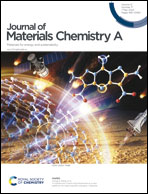Microcosmic modulation of the Co–N bonding structure improves the multi-functional electrocatalytic performance†
Abstract
Cobalt-based materials are regarded as greatly active and stable catalysts zinc–air batteries (ZABs). However, details of Co active units are particularly elusive, and it is notoriously difficult to implement precise control, impeding the further improvement of electrochemical performance. Herein, theoretical models of Co–Nx (x = 2 and 4) are systematically designed and studied; the Co–N2 model can effectively perfect the rate-determining steps for the oxygen reduction reaction (*O → *OH, 0.27 eV) and oxygen evolution reaction (*OOH → * + O2, 0.25 eV). On this basis, utilizing a pyrolysis-free route, the well-defined Co–N2 structure is precisely designed and constructed in the specified atomic configuration. The method proposes atomic precision to regulate the bonding type of M−N2 units (M = Fe, Cu, and Ni). As expected, co-poly(5,10,15,20-tetrakis(4-aminophenyl)porphyrin) with Co–N2 active units (Co-PTAPP) demonstrates a rapid kinetic process (34.7 mV dec−1), superior to that of the porphyrin organic covalent material with Co–N4 active centers (Co-POC), matching well with calculated results. In addition, a high-efficiency water uptake hydrogel (PVA-IL), with 1-hydroxylethy-3-methylimidazolium chloride (HOEtMImCl) as the hydrating agent, is efficiently synthesized. Applying optimized PVA-IL in flexible ZABs enables a long discharge time (500 min) at 4 mA cm−2, surpassing that of the PVA hydrogel.



 Please wait while we load your content...
Please wait while we load your content...